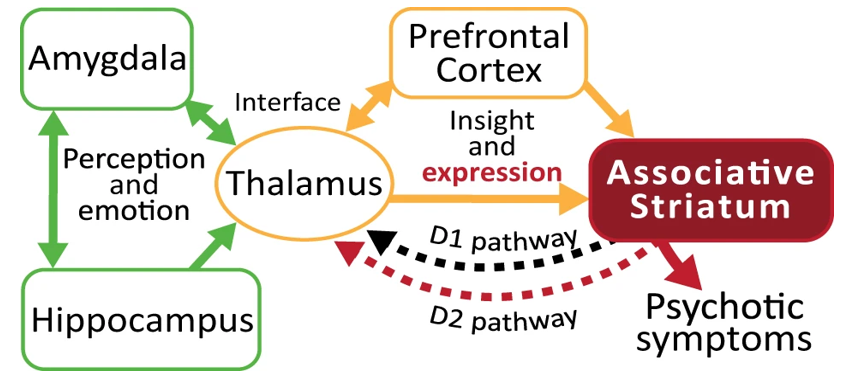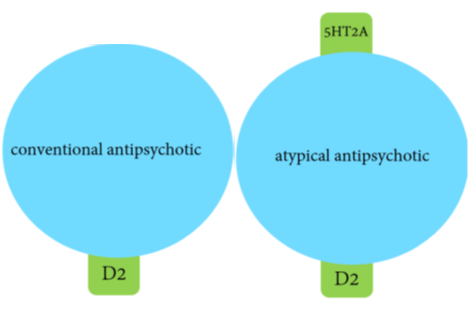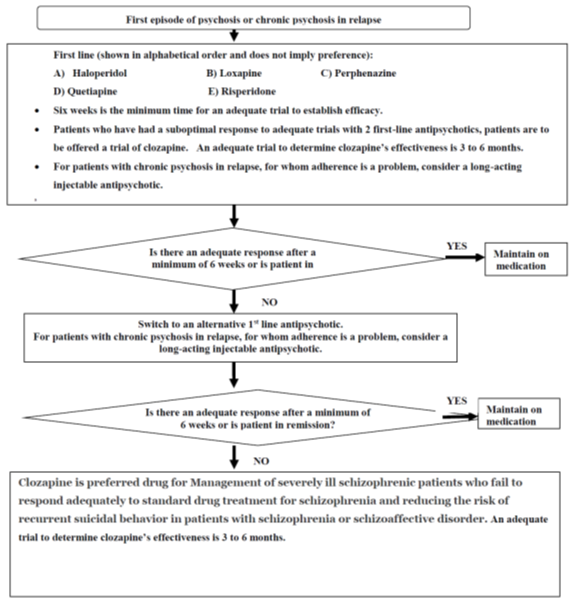Introduction
Defining psychosis
Psychosis is used to describe conditions that affect the mind, where there has been some loss of contact with reality. Symptoms of psychosis include delusions (false beliefs) and hallucinations (seeing or hearing things that others do not see or hear). Other symptoms include incoherent or nonsense speech, and behaviour that is inappropriate for the situation.1
Types of psychosis
Schizophrenia spectrum” (DSM-5 terminology) or the group of “schizophrenia and other primary psychotic disorders are classified
Brief psychotic disorder : There are three different possible types of brief psychotic disorder:
Brief psychotic disorder with a marked stressor(s) - When a psychotic episode is triggered by an emotionally stressful event or events in an individual’s life
Brief psychotic disorder without a marked stressor(s) – When a psychotic episode occurs without any stressful event acting as a trigger
Brief psychotic disorder with postpartum onset – When a psychotic episode occurs during pregnancy or within the 4 weeks postpartum.
Common symptoms are Delusions, hallucinations, disorganised speech, catatonic behaviour.2
Drug- or alcohol-related psychosis: Drugs, including stimulants such as methamphetamine and cocaine. Drugs like steroids and stimulants can also cause symptoms of psychosis. Psychosis associated with alcohol can occur with acute intoxication, alcohol withdrawal, as well as in chronic alcoholics
Organic psychosis: An organic psychosis is an organic (ie physical) disease, which causes mental illness. It can either be a disease of the brain (eg embolism, infection, tumour or trauma)
Schizoaffective disorder: People have symptoms of both schizophrenia and a mood disorder, such as depression or bipolar disorder.
Schizophreniform disorder: This includes symptoms of schizophrenia but the symptoms last for a shorter time: between 1 and 6 months.
Schizophrenia: DSM (Diagnostic and Statistical Manual of Mental Disorders) -5 have following as listed criteria:
Two or more of the following for at least a one-month (or longer) period of time, and at least one of them must be 1, 2, or 3:
Delusions
Hallucinations
Disorganized speech
Grossly disorganized or catatonic behaviour
Negative symptoms, such as diminished emotional expression
Schizophrenia: is a serious mental disorder in which people interpret reality abnormally. Schizophrenia may result in some combination of hallucinations, delusions, and extremely disordered thinking.
Paranoid-type schizophrenia is distinguished by paranoid behaviour, including delusions and auditory hallucinations. Paranoid behaviour is exhibited by feelings of persecution, of being watched,
A person with disorganized-type schizophrenia will exhibit behaviours that are disorganized or speech that may be bizarre or difficult to understand.
Catatonic Schizophrenia: People with this type of schizophrenia may vary between extremes: they may remain immobile or may move all over the place.
Undifferentiated-type schizophrenia is a classification used when a person exhibits behaviours which fit into two or more of the other types of schizophrenia.
Residual Schizophrenia: When a person has a past history of at least one episode of schizophrenia, but the currently has no symptoms.3, 4
Symptoms: Psychotic symptoms can generally be divided into positive, negative, and cognitive symptoms. [Table 1]
Cognitive Impairment: These impairments include problems with attention, memory, and executive function (i.e., abstraction, problem-solving, insight, and cognitive flexibility).
Table 1
|
Positive Symptoms |
Negative Symptoms |
|
Hallucinations |
Affective flattening |
|
Delusions |
Alogia / Avolition / Anhedonia |
|
Disorganised behaviour |
Asocial |
|
Disturbed language |
|
Mood symptoms are commonly present in individuals with psychotic symptoms and usually require treatment.5
Table 2
Cognitive impairment in psychosis
The cognitive symptoms are the most disabling and misunderstood of all the symptom complexes associated with psychotic disorders.6
Cause of psychosis
Psychosis may occur as a result of many conditions. Psychosis is most commonly found in mental illnesses, including psychotic disorders and mood disorders. Psychosis can be related to many other things, including: The use of cannabis (marijuana). Cannabis has been linked to the onset of schizophrenia in some studies Other causes of psychosis include alcohol and other illegal drugs such as amphetamine (speed), cocaine, methamphetamine, mephedrone MDMA (ecstasy), LSD (acid), psilocybin (mushrooms), ketamine and opiates (heroin). Physical issues such as epilepsy, Parkinson’s disease, Wilson’s disease (inability to process copper), Huntington’s disease, chromosomal disorders, brain tumours, dementia, Lyme disease, multiple sclerosis and stroke. Lack of sleep, Very poor nutrition. The use of some prescription drugs, such as steroids, opiates (codeine, morphine) and stimulants, including medication for ADHD (Attention deficit hyperactivity disorder).7
Mechanisms of Psychosis
Biochemical
Glutamate is the most abundant excitatory neurotransmitter in the cerebral cortex. Although the common antipsychotics act on dopamine receptors, the hypofunction of the ionotropic glutamate N-methyl-D-Aspartate (NMDA) receptor has been proposed as a mechanism in schizophrenia.8]
In the case of schizophrenia, the dopamine hypothesis proposes that dopamine transmission is overactive in the mesolimbic areas and underactive in the prefrontal cortex. Dopamine dysregulation is also seen in the amygdala, which is involved in emotional processing. The positive symptoms of schizophrenia are hyperactive dopaminergic signal transduction. The overactivation of D2 receptors, specifically, is one effect of the global chemical synaptic dysregulation observed in this disorder. Figure 18
The Role of Serotonin in Schizophrenia: Decreased levels of 5-hydroxyindoleacetic acid in cerebrospinal fluid have been found to be correlated with cortical atrophy or ventricular enlargement in schizophrenic patients. There is increasing interest in the correlation between negative symptoms of schizophrenia and 5-HT(2) receptors. The rationale for these studies is the hypothesis that abnormal neurotransmission at 5-HT(2) receptors may be involved in the pathophysiology of schizophrenia. 9
Cytokines: Increased levels of IL-6 in different groups of patients including, first-episode and drug-naive (FEDN) psychosis patients. Multiple studies, including meta-analyses, reported elevated levels of TNF-α, one of the other pro-inflammatory cytokines. Several studies, including some meta-analyses, found elevated levels of IFN-γ in chronic schizophrenic patients who were stable or were experiencing an acute relapse.
Glycine is an α-amino acid, which also has a role as an inhibitory neurotransmitter via binding to strychnine-sensitive glycine receptors. Some randomized controlled trials (RCT) with oral glycine suggested improvement of negative symptoms. D-serine or D-alanine also have shown efficacy for the treatment of negative symptoms.10
Epigenetic mechanisms encompass several pathways that can mediate gene-by-environment interactions and modulate gene expression and activity without altering the DNA sequence. These include, among others, DNA methylation, histone modifications, chromatin remodeling, and the actions of noncoding RNAs. 11
Principles of antipsychotic prescribing
Treatment with antipsychotic medication, like any other treatment, should be individualized in order to optimally promote recovery.
Treatment with antipsychotic medication should be as effective, safe, and well tolerated as possible
Treatment with antipsychotic medication should consider personal preference and vulnerabilities.
Treatment with antipsychotic medication should provide value in terms of improved quality of life to the consumer.
Treatment choices should be informed by the best current evidence and must evolve in response to new information.
Cost considerations should guide antipsychotic medication selection once the preceding principles are met.12
Classification of antipsychotic drugs: Table 3: [ESPE -extrapyramidal side effects]
Table 3
Typical Antipsychotic drugs such as haloperidol , Thiothixene chlorpromazine also referred as FGA (First generation antipsychotics) tend to block dopamine D2 receptors in the dopaminergic pathways of the brain. Excess release of dopamine in the mesolimbic pathway has been linked to psychotic episodes.
Atypical antipsychotic drugs or second generation antipsychotics (SGA) have a similar blocking effect on D2 receptors; however, most also act on serotonin receptors, especially 5-HT2A and 5-HT2C receptors. Both clozapine and quetiapine appear to bind just long enough to elicit antipsychotic effects but not long enough to induce extrapyramidal side effects and prolactin hypersecretion.13
Therapeutic drug monitoring
Therapeutic drug monitoring is not strictly necessary for all of the new antipsychotic drugs because there are no unequivocal data supporting a relationship between plasma drug levels and clinical outcomes or side effects. There has been success in defining the minimum therapeutic response threshold for certain antipsychotics—for example, clozapine (350 to 450 ng/mL), haloperidol (3 to 5 ng/mL), and fluphenazine (0.8 ng/mL).14, 15
Guidance on the use of Antipsychotics
The antipsychotic medications have two applications:
Reduce severe or acute symptoms to a level, where they are manageable. Sometimes the effect is seen early but in general it takes 2-4 weeks to show response
Prevention of relapses.
With the exception of clozapine, the efficacy of all antipsychotics is very similar andoften the choice is governed by the side effect profile of the antipsychotic. Poor compliance with oral antipsychotics is common in patients with schizophrenia, mania and other psychoses which often results in a relapse of the illness. The use of depot medication can be considered for use in these situations as it promotes adherence to medication, allows for earlier detection of non-adherence with the potential for earlier intervention and possible decreased risk of severe relapse. All patients receiving long term treatment with antipsychotic medication should be monitored routinely and regularly. Treatment resistance is described as being resistant to adequate trials of at least two antipsychotics. In such circumstances service users must be offered a trial of clozapine at the earliest opportunity. Clozapine started given with monitoring of white blood cells (WBCs) count. By its heavy dose if agranulocytosis occurs then must discontinue the clozapine. Augmentation therapy is given with second generation antipsychotics combine with electroconvulsive therapy (ECT) Currently, effective treatments for cognitive deficits are thought to be the greatest unmet needs. Numerous recent clinical trials have suggested only modest benefits on cognitive function in schizophrenia relative to first- and second-generation antipsychotics when dosed properly.16, 17
Switching from one antipsychotic to another is frequently indicated due to an inadequate treatment response or unacceptable adverse effects. It should be carried out cautiously and under close observation. There are a number of clinical situations in which switching from one antipsychotic to another is considered.
Inadequate clinical response for acute symptoms despite dose optimisation and adequate duration of treatment trial.
Poor control of chronic symptoms and persistence of functional disabilities during maintenance therapy.
Relapse despite adequate prophylactic or maintenance treatment of a psychotic illness.
Persistence of certain symptoms of psychotic illness (e.g. negative symptoms and cognitive dysfunction) despite adequate doses of one antipsychotic, which may respond better to an alternative drug.
Unacceptable adverse effects at low therapeutic doses before a clinical response in susceptible individuals (e.g. extrapyramidal effects in Asian patients). Consider switching to an antipsychotic with a lower risk for the adverse effect.18
Algorithm- Antipsychotic Selection in Schizophrenia and Schizoaffective Disorder [Figure 2]
Primary indications for Clozapine is in patients with schizophrenia or schizoaffective disorder are schizophrenia symptoms partially or fully resistant to treatment with other antipsychotic drugs, or accompanied by persistent suicidal or self-injurious behaviour.19, 20, 21
Glycine therapy
Glycine (an amino acid sold as a dietary supplement) has been a subject of research for over 15 years as a potential treatment for the negative symptoms of schizophrenia. Clinical trials suggest that the optimal dosage may be in the range of 30 grams to 60 grams a day. The biggest downside to taking glycine seems to be upset stomach and nausea. Glycine may turn out to be a beneficial supplemental treatment (when added to standard antipsychotic medications).22
ADR Profile of antipsychotics
The effects range from relatively minor tolerability issues (e.g., mild sedation or dry mouth) to very unpleasant (e.g., constipation, akathisia, sexual dysfunction) to painful (e.g., acute dystonia) to disfiguring (e.g., weight gain, tardive dyskinesia) to life-threatening (e.g., myocarditis, agranulocytosis). Parkinsonism, tardive dyskinesia, neuroleptic malignant syndrome and hyperprolactinemia are considered to be a result of acute or chronic blockade of DA receptors, while histamine-H1 and 5-HT2Creceptors may contribute to antipsychotic-induced weight gain.
Neuroleptic malignant syndrome (NMS) is a life-threatening emergency that closely resembles malignant hyperthermia (MH). It is characterized by hyperthermia, muscle rigidity, severe hypermetabolic dysautonomia, and mental status changes. It can be triggered by a single dose of any antipsychotic, but is most commonly associated with the high potency FGAs, including haloperidol and droperidol. MH, first-line management is dantrolene (0.5-2.5 mg/kg every 6-12 hours), aggressive hydration, and supportive management.
Adverse events of antipsychotics reduce patients' quality of life, compliance with taking the antipsychotics (and thereby also relapse) and the stigma experienced. Other features can include neutrophilia and occasionally haemorrhagic tendency 23, 24, 25
The American Psychiatric Association's latest guidance recommends thorough physical exam and laboratory screening, with ECG.
Table 4
Degree of QTc prolongation
|
|
High |
Mid |
Low |
|
Conventional antipsychotics |
Thioridazine |
Chlorpromazine |
Haloperidol |
|
Atypical Antipsychotics |
Ziprasidone |
Quetiapine |
Risperidone |
|
|
|
|
Clozapaine |
|
|
|
|
Olanzapine |
|
|
|
|
Aripiprazole |
Antipsychotics are associated with a 1.5 to 4‐fold increase in risk of sudden cardiac death. There is no evidence that second‐generation antipsychotics are safer than first‐generation drugs as a class.
Natural Medicines for Psychosis
In 110 randomized controlled trials, evidence was found for glycine, sarcosine, N-acetylcysteine, some Chinese and ayurvedic herbs, ginkgo biloba, and estradiol to improve psychotic symptoms when added to antipsychotics. Ginkgo biloba and vitamin B6 seemed to reduce tardive dyskinesia and akathisia. Inconsistent beneficial outcomes of studies on B vitamins were, especially when given as a combination of B1, B3, B9, and/or B12 with antipsychotics. No adequate support for the efficacy of B vitamins in schizophrenia can be identified, except B6 26
Conclusion
Antipsychotic medications are the mainstay t for psychosis, with second-generation antipsychotic (SGA) medications generally considered the drugs of first choice Conventional and atypical antipsychotics are used as the foundation for the pharmacological management of schizophrenia and related psychosis. All antipsychotics are considered to be of equal efficacy, with the exception of Clozapine. The newer atypical agents are generally better tolerated and have less EPSE than the older conventional agents. It has long been recognized that conventional antipsychotics can increase the risk of EPS and tardive dyskinesia in elderly patients, so atypical antipsychotic has gradually replaced conventional antipsychotics in elderly patients. Notwithstanding controversial data, antipsychotics are probably the best option for short-term treatment (6–12 weeks) of severe, persistent, and resistant aggression. The possibility of serious adverse events restricts long-term therapy and clinician should decrease dosage and discontinue treatment wherever a sufficient control of behavioural symptoms has been obtained.




